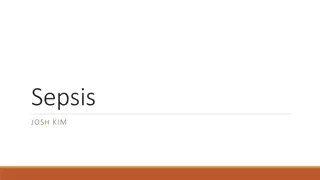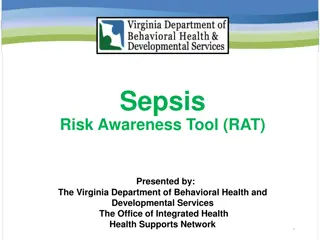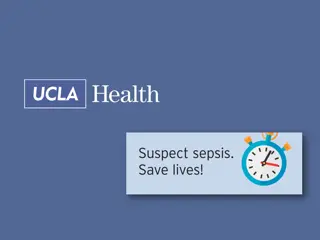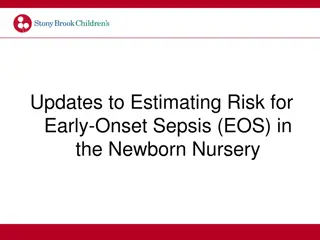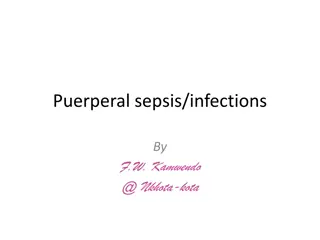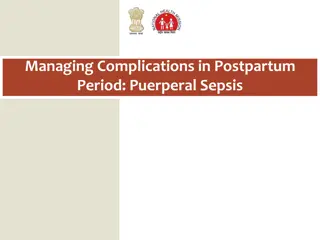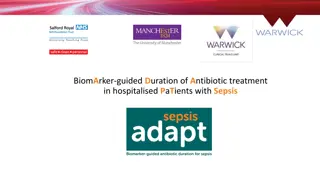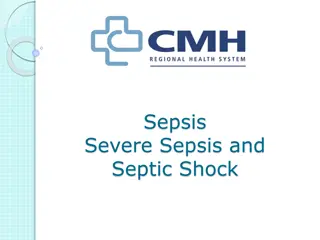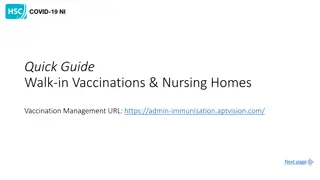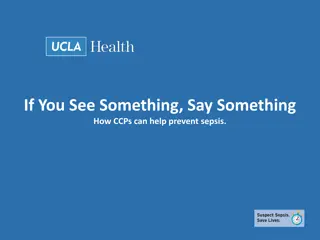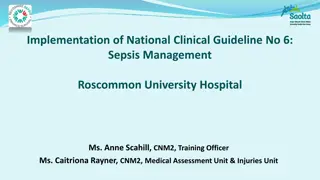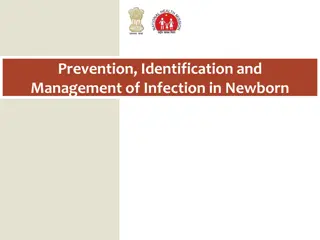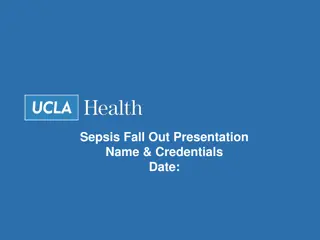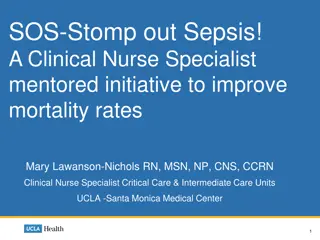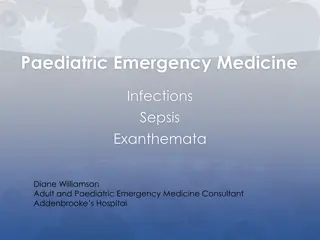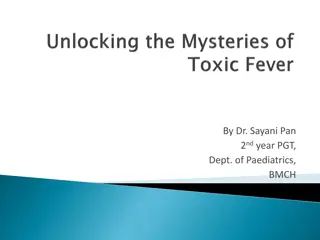Importance of Vaccinations in Sepsis Prevention
Sepsis is a life-threatening response to infection that can lead to organ failure and death. Infection prevention through vaccinations is crucial to combat sepsis. Best practices include obtaining vaccination consent, offering education, and co-administering vaccines to older adults. Accessing vaccine records and promoting vaccination coverage among adults aged 65 and over are key strategies highlighted in the bulletin board bundle.
Uploaded on Sep 20, 2024 | 1 Views
Download Presentation

Please find below an Image/Link to download the presentation.
The content on the website is provided AS IS for your information and personal use only. It may not be sold, licensed, or shared on other websites without obtaining consent from the author. Download presentation by click this link. If you encounter any issues during the download, it is possible that the publisher has removed the file from their server.
E N D
Presentation Transcript
The following information is intended to support your facility s vaccination education and promotion efforts. Bulletin Board Bundle: Sepsis and Vaccination Print and display the pages as is or customize them with additional information or your facility s logo (space allotted in the top right corner of each slide). The content can be used on bulletin boards, in staff common areas, and at staff or family council meetings. The information provided in this resource is based on vaccine information and guidance as of the package release date. This material was prepared by Health Quality Innovators (HQI), a Quality Innovation Network-Quality Improvement Organization (QIN-QIO) under contract with the Centers for Medicare & Medicaid Services (CMS), an agency of the U.S. Department of Health and Human Services (HHS). Views expressed in this material do not necessarily reflect the official views or policy of CMS or HHS, and any reference to a specific product or entity herein does not constitute endorsement of that product or entity by CMS or HHS. 12SOW/HQI/QIN-QIO-0573-08/02/23
Catch Up On Vaccines: Sepsis Matters! What is Sepsis? Sepsis is the body s extreme response to an infection. It is a life-threatening medical emergency. Without timely treatment, sepsis can rapidly lead to tissue damage, organ failure and death. How Does Someone Become Septic? Sepsis starts as an infection that gets into the blood stream, multiplies rapidly and travels quickly through the body. The body responds by sending white blood cells, which causes extreme inflammation. Source: Centers for Disease Control and Prevention
Infection Prevention is the Best Way to Prevent Sepsis Vaccinations are important tools in the fight against infections Vaccinations can prevent illness by killing the infection-causing organism or minimizing the impact of the illness Vaccinations are much safer than hoping you will get the infection and develop immunity you avoid the serious effects of the illness itself Best Practices: Obtain vaccination consent and history at admission Incorporate vaccination training into all staff onboarding If you can't find records, ask the prescriber if you can administer vaccines Provide post-vaccination education and offer to answer questions the resident and/or family may have
Co-administer Vaccinations to New Admissions and at Vaccine Clinics Vaccines Recommended for Older Adults: COVID-19 Influenza Pneumococcal Shingles Tetanus RSV Looking for Vaccine Records? Primary care provider office patient portals Usual pharmacy Previous facility State Immunization Registry Public health clinics Veterans Affairs Local hospital systems Insurance records Former employers Ask the resident and family to help Note: Disparity with Vaccinations in Age>65: Vaccine coverage highest for white adults (non-Hispanic) Vaccine coverage lowest for poor adults Vaccination Coverage Among Adults Aged 65 and Over: United States, 2015 Getting a Flu Vaccine and a COVID-19 Vaccine at the Same Time | CDC
Vaccinate for Flu and Pneumonia to Avoid Sepsis Pneumonia is the #1 cause of sepsis: 50% of sepsis cases Pneumonia is the second most common cause of infection in nursing homes Flu can lead to pneumonia Pneumonia in NH residents may present as lethargy, confusion and falls, but also assess for more typical signs: cough, hypoxia, SOB, fever 1.3 million ED visits have pneumonia as a primary diagnosis The Agency for Healthcare Research and Quality s Intramuscular Injections - Best Practices for Safe Vaccine Administration in Nursing Homes (AHRQ) Intramuscular Injections - Best Practices for Safe Vaccine Administration in Nursing Homes tool outlines best practices for safe vaccine administration Intramuscular Injections - Best Practices for Safe Vaccine Administration in Nursing Homes Intramuscular Injections - Best Practices for Safe Vaccine Administration in Nursing Homes Intramuscular Injections - Best Practices for Safe Vaccine Administration in Nursing Homes Intramuscular Injections - Best Practices for Safe Vaccine Administration in Nursing Homes Scan to access McKesson s Pneumonia Resources Scan to access McKesson s Pneumonia Resources Scan to access the CDC s Vaccination Coverage Among Adults Aged 65 and Over
Shingles in Nursing Home Residents The risk of shingles increases with age The risk of complications, hospitalization and death from shingles increases with age Postherpetic neuralgia (severe nerve pain from shingles) risk increases with age 33% of people in the U.S. will get shingles in their lifetime The Shingrix vaccine is over 90% effective at preventing shingles Incidence increases with age, 50% in those over 85 Mortality rate, mainly a risk for immunocompromised, is 5-15% A COVID-19 infection increases the risk of shingles Shingles can present with fever, chills, diarrhea, burning sensation, malaise, headache Scan to access the CDC s Shingles (Herpes Zoster) Vaccination webpage Scan to access the CDC s Shingles (Herpes Zoster) Clinical Overview Scan to access the Cleveland Clinic s Shingles webpage
Vaccines Prevent a Cascade of Illnesses: Help Prevent Sepsis Prevent debilitating illness from shingles or infected wounds from shingles to reduce the risk of infection and sepsis Prevent pneumonia or severe pneumonia to reduce the risk of sepsis Tetanus, a devastating illness from dirty wounds, is rare but it can cause pneumonia and sepsis Prevent respiratory infections from influenza, which can lead to sepsis Prevent severe illness from COVID, including secondary infections caused by COVID, which can cause sepsis
Conduct a Performance Improvement Plan Step 1: Determine the Key Areas for Improvement: Complete a medical records review for 8-10 residents who were transferred to the emergency department or admitted to the hospital with sepsis. NOTE: You can choose a different number or timeframe based on your facility s usual patterns of transfer and readmission. Select a meaningful number to help identify any trends. Study documentation by the nurse and other staff. Review other areas, such as lab work, notes from the hospital and vaccination records. Note any diagnostic reasons or other patterns of interest (e.g., vital signs, staff involved, medical director, health disparities, time of day, unit, staffing, etc.). Determine if there were missed opportunities that could have prevented the issue that led to the hospital transfer.



